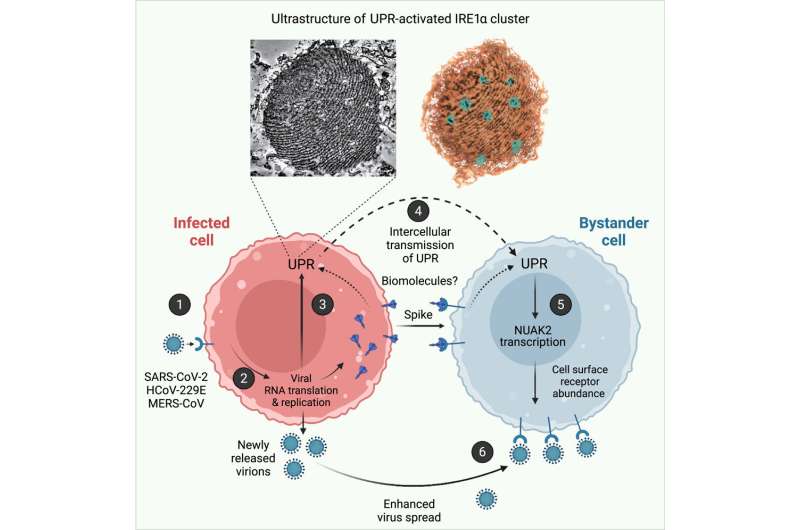This article has been reviewed according to Science X's editorial process and policies. Editors have highlighted the following attributes while ensuring the content's credibility:
fact-checked
peer-reviewed publication
proofread
New infection mechanism in SARS-CoV-2 discovered

Researchers from Heidelberg Medical Faculty, Heidelberg University Hospital and German Cancer Research Center investigate molecular relationships that promote infection and spread of SARS-CoV-2. The results may provide a starting point for development of antiviral therapies. The paper is published in the journal Molecular Cell.
SARS-CoV-2, responsible for the COVID-19 pandemic, triggers a stress response in infected cells that facilitates the virus' entry into the cells.
In their search for the underlying molecular mechanism, researchers from the Heidelberg University Medical School and Heidelberg University Hospital (UKHD), in collaboration with the German Cancer Research Center (DKFZ) and the University of Bristol, identified a cellular factor called NUAK2. Its amount is increased by the SARS-CoV-2 mediated cellular stress response and it promotes the entry and spread of the coronavirus in human cells. Thus, NUAK2 could be a new target for the development of antiviral agents.
The research team led by Professor Ralf Bartenschlager, Head of the Division of Molecular Virology at the Center for Infectious Diseases at UKHD and Dr. Vibhu Prasad, Scientist in Molecular Virology has now analyzed the molecular pathways involved in SARS-CoV-2 infection of the cell. The cellular protein NUAK2 plays a central role in this process.
The Heidelberg scientists blocked NUAK2 in the cells and observed reduced infection of cells by SARS-CoV-2 particles. In subsequent studies, the scientists found that NUAK2 regulates the amount of ACE2, the receptor for the virus, on the cell surface. "In addition, our studies showed that increased NUAK2 levels in infected cells increased the number of receptors in uninfected cells as well. As a result, these cells also became more infected with SARS-CoV-2," reports Dr. Vibhu Prasad.
And these correlations could be demonstrated not only with SARS-CoV-2, but also with other coronavirus species such as human coronavirus-229E—a "common cold virus"—and the very dangerous MERS coronavirus, which can be transmitted from camels to humans.
"The research findings provide valuable insights into the intricate mechanisms of SARS-CoV-2 infection and spread. Understanding the role of NUAK2 opens new avenues for therapeutic intervention. By interrupting NUAK2-regulated virus entry, we might be able to prevent the spread of the virus and thereby mitigate the effects of coronavirus infections," says Bartenschlager.
More information: Vibhu Prasad et al, Enhanced SARS-CoV-2 entry via UPR-dependent AMPK-related kinase NUAK2, Molecular Cell (2023). DOI: 10.1016/j.molcel.2023.06.020
Journal information: Molecular Cell
Provided by Universitätsklinikum Heidelberg




















